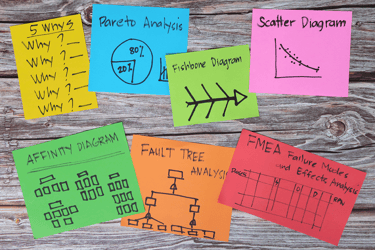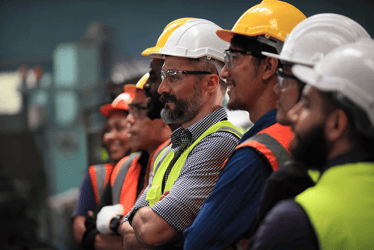The Packaging Industry's Sustainability Challenge: Why ERP Systems Are Essential for Success A straightforward guide to navigating sustainability regulations across folding carton, flexible...
Compliance Guide for the EU’s Packaging and Packaging Waste Regulation
In 2022, the EU generated an estimated total volume of 83.4 million tonnes of packaging waste, highlighting the need for better waste management.
This article explores the Packaging and Packaging Waste Regulation (PPWR) role in addressing this issue, its key aspects, its significance, and how businesses can comply.
Contents
- What is the PPWR?
- Why the PPWR Matters
- Understanding the EU's Packaging and Packaging Waste Regulation (PPWR)
- Key Requirements and Obligations for Businesses under the PPWR
- How Can Businesses Comply with the PPWR?
- Conclusion
What is the PPWR?
The Packaging and Packaging Waste Regulation (PPWR) is a significant European Union regulation designed to overhaul how packaging is designed, produced, and managed across all member states. Replacing the existing Packaging Waste Directive, it introduces a more ambitious framework with a focus on waste reduction, sustainability, and a circular economy.
The regulation sets mandatory requirements for packaging recyclability, minimum recycled content, compostability, and labeling, placing full lifecycle responsibility on producers. It applies to almost all industries and packaging types, aiming to reduce the environmental impact of packaging waste across the EU.
Why the PPWR Matters
The EU is taking decisive action to tackle the growing environmental challenge of packaging waste. In 2021, each European produced 188.7 kg of packaging waste per year, a figure projected to rise to 209 kg by 2030 without intervention.
The PPWR seeks to foster a circular economy by ensuring that resources are used as long as possible and waste is minimized. By addressing every stage of a product's lifecycle, from design to disposal, the regulation encourages the reintroduction of recyclable materials into manufacturing processes.
Understanding the EU's Packaging and Packaging Waste Regulation (PPWR)
The PPWR introduces new requirements and targets to reduce packaging waste and promote recycling, reuse, and sustainability. It replaces the existing Packaging Waste Directive with a more stringent and comprehensive framework. The regulation sets a series of minimum packaging design requirements that must be met for packaging to be allowed on the EU market.
The PPWR applies broadly to all packaging materials across most industries, including industrial, retail, distribution, and households. However, it's important to note an exemption for design rights and trademarks protected by the date the regulation comes into force.
Obligated producers include any manufacturer, importer, or distributor introducing packaging into the EU market. These producers have specific responsibilities for compliance and traceability.
Some of the key objectives of the PPWR include:
- Reduce packaging waste: The PPWR intends to reduce the amount of packaging waste generated in the EU, introduce restrictions on what packaging can be used, and promote reusable and refillable packaging solutions.
Each Member State is required to progressively reduce the packaging waste generated per capita by at least 5 percent by 2030, 10 percent by 2035, and 15 percent by 2040, compared to a 2018 baseline level. - Adopting harmonized rules: EU-wide rules on labeling, void space, and mandatory recycled content will promote a level-playing field across the EU, with the same rules applying to all.
- Boosting high-quality recycling: The PPWR aims to make all packaging on the EU market recyclable in an economically viable way by 2030. The PPWR also details recycling targets of packaging waste by weight that Member States must meet:
|
|
|
|
|
|
All Packaging |
55 |
65 |
70 |
|
Plastic |
25 |
50 |
55 |
|
Wood |
15 |
25 |
30 |
|
Ferrous Metals |
50 (incl. Al) |
70 |
80 |
|
Aluminium |
- |
50 |
60 |
|
Glass |
60 |
70 |
75 |
|
Paper and Cardboard |
60 |
75 |
85 |
Key Requirements and Obligations for Businesses under the PPWR
The PPWR introduces several key requirements that businesses need to be aware of:
Sustainability Requirements
Recyclable Packaging
By 2030, all packaging must be designed to be recyclable in an economically viable way. This means that the packaging must be able to be collected, sorted, and recycled using existing infrastructure and technologies.
The PPWR will introduce specific recyclability grades to assess the ease and efficiency with which packaging can be recycled. These grades will consider factors such as the material composition, the presence of contaminants, and the ability to separate different components for recycling.
The PPWR sets minimum recycled content requirements for plastic packaging. Starting January 1, 2030, any plastic part of packaging placed on the market must contain a minimum percentage of recycled content recovered from post-consumer plastic waste. The specific percentage will depend on the packaging type and format.
For instance, contact-sensitive packaging made from Polyethylene Terephthalate (PET) will need to contain at least 30% recycled content. This is part of the broader goal to increase the demand for recycled plastics and reduce reliance on virgin materials.
However, certain types of packaging are exempt from these requirements. For example, medical packaging and transport packaging for dangerous goods may not include recycled content, as it could pose safety or hygiene risks.
Compostable Packaging
Certain packaging, such as labels on fresh produce and coffee pods, will need to be compostable. This means that the packaging must be able to break down into natural materials in a composting environment, without leaving behind harmful residues.
The PPWR will align with specific composting standards to ensure that compostable packaging meets the necessary requirements for biodegradability and compost quality.
Design Requirements
The regulation mandates design changes to minimize harmful substances, ensuring packaging is safer and more sustainable. For example, food contact packaging must meet strict standards within 18 months of the regulation's effective date. This includes restrictions on the use of certain chemicals and materials that could migrate into food and pose health risks.
The PPWR also aims to reduce the overall amount of packaging used. This involves minimizing both the weight and volume of packaging to the necessary minimum.
Packaging that artificially increases the perceived product volume through features like double walls, false bottoms, or similar elements is not permissible. Additionally, the empty space in packaging, filled with materials such as air cushions or foam, must not exceed 50% of the total volume.
These requirements encourage businesses to optimize their packaging designs, using fewer resources and reducing waste.
Labelling
New labelling requirements will help consumers sort packaging correctly. Labels will clearly show material composition and provide recycling instructions. The PPWR may also introduce the option of using QR codes on labels to provide consumers with additional information about the packaging, such as its recyclability, recycled content, and proper disposal methods.
Extended Producer Responsibility (EPR)
The regulation enforces EPR, requiring producers to take responsibility for the entire lifecycle of their packaging, including its disposal and recycling. This means that producers will need to finance and organize the collection, sorting, and recycling of their packaging waste.
To comply with EPR requirements, companies must enroll in a national register and remit corresponding fees, as well as adhere to regular reporting of their packaging activities.
How Can Businesses Comply with the PPWR?
Digital Tools to Support Compliance
Meeting the requirements of the PPWR can be complex, particularly when it comes to tracking materials, managing carbon data, and generating accurate reports. Software designed specifically for the packaging industry can help address these challenges by improving visibility, automating reporting, and supporting more sustainable production processes.
For example, tools like Radius ERP offer functionality that supports compliance with regulations like the PPWR, including carbon footprint tracking, material traceability, and waste reduction workflows.
Waste Reduction
Waste reduction is a key objective of the PPWR. Enterprise Resource Planning (ERP) systems can support this by helping businesses minimize job underruns and overruns, reduce material waste, and lower the time required for order fulfillment. By optimizing resource utilization, ERP systems enable more efficient production with less waste.
Packaging Carbon Footprint
Understanding the carbon footprint of packaging is increasingly important as regulations like the PPWR push for greater environmental transparency and accountability. Tracking emissions at the job or item level allows businesses to evaluate the environmental impact of their material choices, production methods, and transportation processes. This kind of visibility supports more informed decisions that align with the regulation’s eco-design principles.
Digital tools that provide certified carbon footprint data can help reduce reliance on manual reporting and support the use of standardized metrics. This not only streamlines compliance but also helps companies avoid greenwashing by offering transparent, third-party-verified data. Over time, this kind of insight can support progress toward broader sustainability targets, such as Net Zero goals.
Material Tracking
One of the core requirements under the PPWR is the use of recycled content in packaging. This makes accurate tracking of materials - from raw inputs to finished packaging - increasingly important. Being able to identify the percentage of recycled content not only supports compliance but also improves transparency with both regulators and consumers.
Real-time material visibility can help businesses make better decisions, identify inefficiencies, and spot opportunities to reduce reliance on virgin resources.
Inventory Management
Smart inventory management plays a key role in reducing packaging waste. Avoiding overproduction, minimizing offcuts, and ensuring the right materials are available when needed can all help optimize resource use.
Digital tools that connect shop floor operations with scheduling and procurement systems can make this process more efficient - improving accuracy, reducing waste, and lowering environmental impact.
Traceability
Traceability is becoming a foundational expectation for packaging producers, especially as Extended Producer Responsibility (EPR) becomes more widely enforced. Being able to follow a package’s lifecycle - from raw materials to end-of-life - allows businesses to demonstrate accountability and better assess their environmental footprint. This transparency is also vital for validating carbon scores and sustainability claims, as required by evolving regulations like the PPWR.
Reporting
With the PPWR introducing new data and reporting obligations, businesses are under increasing pressure to monitor their packaging activity more closely. Tools that can automate data collection and provide consistent reporting - especially around metrics like recycled content, recyclability, and carbon impact - are becoming essential. Reliable data helps reduce the risk of non-compliance and supports measurable progress toward waste reduction and emissions targets.
Conclusion
The EU's PPWR presents a significant shift in how businesses approach packaging. It requires companies to take a more holistic and sustainable approach to their packaging processes, from design to disposal. While this presents challenges, it also creates opportunities for innovation and improved efficiency.
Radius ERP and Packaging Suite offer a comprehensive set of tools that can help businesses execute PPWR programs with no incremental internal costs due to the automated reporting. With relevant features such as material tracking, scrap reduction, inventory management, traceability, and reporting, facilitating measurable waste reduction and integrated PPWR compliance. With the integrated carbon footprint scoring, converters will be able to have an additional layer of measurability that ensures success.
In addition, the PPWR also emphasizes the importance of effective communication between companies and consumers regarding reusable packaging options. Businesses need to be transparent about their packaging choices and educate consumers about how to properly dispose of or reuse packaging. This will require clear labeling, consumer education campaigns, and potentially the use of digital tools like QR codes to provide easy access to information.
By embracing these strategies and adopting these solutions, businesses can actively engage consumers in the transition towards a more circular economy for packaging, while also meeting their compliance obligations. This approach not only enhances operational efficiency but also contributes to a more sustainable future.




